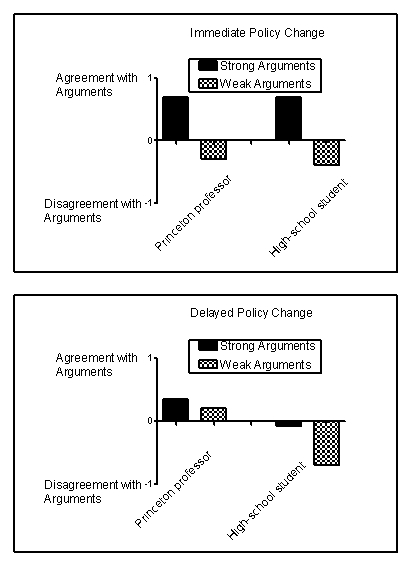Scenario II
The following scenario contains fabricated results consistent with the following study:
Petty, R. E., Cacioppo, J. T., & Goldman, R. (1981) . Personal involvement as a determinant of argument-based persuasion. Journal of Personality and Social Psychology, 41, 847-855.
Every day, consumers are exposed to scientifically based sales, marketing, and public relations strategies designed to influence purchasing decisions, change opinions, or win votes. One common sales strategy is the foot-in-the-door technique, a method that involves first making a smaller request that consumers are likely to grant and then following it by a larger request. Another common strategy is the door-in-the-face technique, which involves making an unreasonably large request that consumers will reject and then following it by a smaller request. When persuasion is necessary, it usually takes one of two forms: heuristic persuasion involves an appeal to habits or emotion, and systematic persuasion involves an appeal to facts and reason. Often, people will rely more on heuristics-simple short-cuts or "rules of thumb"-to make decisions instead of systematically weighing the evidence.
Petty and colleagues (1981) investigated some of these techniques in college students listening to arguments in favor of their college requiring an institution-level comprehensive final examination for graduation. Some students were led to believe that, if adopted, this policy would take place right away, and some were led to believe that the change would take place in a decade. In addition, some of the students were led to believe that they were listening to an argument from a Princeton professor, and others were led to believe that they were listening to an argument from a high-school student. Finally, some students heard strong arguments in favor of the policy, and some heard weak arguments. Thus, the experiment arranged six groups of students. For example, one group of students heard strong arguments from a high-school student about a far-removed policy change. Figure 13.1 shows fabricated results illustrating the major findings of this experiment.
Figure 13.1 
-(Scenario II) In the Petty et al. (1981) experiment, which is the best example of a heuristic?
Definitions:
Absorption Costing
A pricing technique that integrates all expenses related to production, such as direct materials, direct labor, along with both variable and fixed overhead costs, into a product's cost.
Operating Income
Earnings before interest and taxes (EBIT), representing the profit from a company's main business activities.
Gross Profit
The difference between the revenue generated from sales and the cost of goods sold, excluding operating expenses, interest, and taxes.
Cost Of Goods Manufactured
The total production cost of goods that were completed during a specific accounting period, including labor, material, and overhead costs.
Q13: Which of these is considered attractive across
Q27: Which personality disorder is part of the
Q45: People usually struggle for years with learning
Q58: Optimists stick to the medical regimens their
Q68: The general adaptation syndrome in reaction to
Q96: People are often not aware of the
Q110: Men with a Type _ behavior pattern
Q141: Political candidates are eager for endorsements from
Q148: Which of these is NOT a defining
Q156: When her sister was born, 4-year-old Gracie